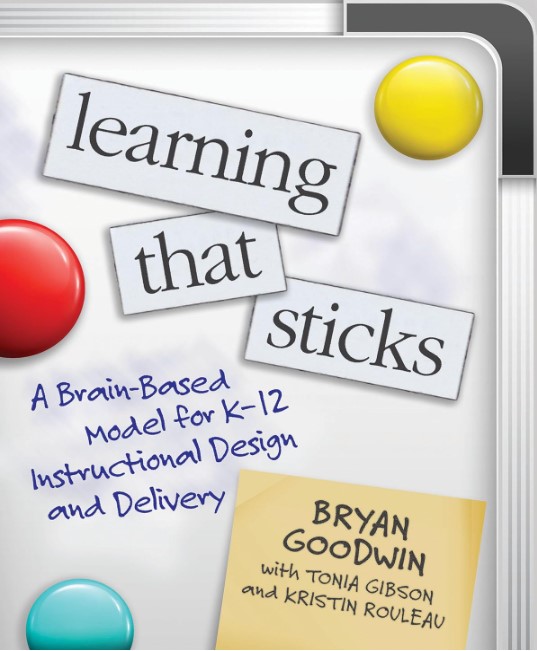Back to Blog
CATESOL Book Review Reflection: Learning That Sticks: A Brain-Based Model for K-12 Instructional Design and Delivery by Bryan Goodwin, Tonia Gibson, Kristin Rouleau
08/19/2024
Michelle Skowbo
Learning That Sticks: A Brain-Based Model for K-12 Instructional Design and Delivery First Edition 2014. Illustrated Edition published 2020

Roger W. Anderson, Independent Scholar, Monterey, CA
Forgetting is a natural human process. Fast learning means fast forgetting. The practices of basketball players and elite ice skaters teach us valuable insights about learning. These are a few of the many insights offered in the book Learning That Sticks: A brain-based model for K-12 instructional design and delivery. This enjoyable, quick read was designed for busy, classroom instructors. It summarizes key findings from cognitive science and presents them as actionable, classroom-ready tips for pedagogy.
Remembering that it focuses on learning generally, not specifically language learning, all readers interested in improving the teaching and learning of any subject, at any level, will benefit. So useful for language teachers, this book was selected as the basis of a 2023 StarTalk program through Concordia Language Villages in Bemidji, MN (USA).
The preface lays out the author’s model of learning, or steps that must occur for learning (that sticks) to take place. Chapters follow this progression: becoming interested, committing to learning, focusing on new learning, making sense of learning, practicing and reflecting, and extending and applying learning.
Readers will latch on to chapters that resonate with them. I found the chapter riveting on gaining interest. Teachers, as a result of institutional and situational pressures, feel compelled to “cover” material, and in doing so, an opportunity to spark students’ interest or curiosity may be squandered. This chapter includes quotes and study findings that posit curiosity is as equally as important in learning as attention. What’s more, a hierarchy exists of stimuli to which our brains naturally attend: that which arouses the emotions, that which is novel, and finally, that which piques curiosity. To facilitate language that sticks, language teachers cannot forgo embedding such hooks into their lessons.
Thin, readable books like Learning That Sticks are invaluable for educators—no one has the time to read a treasure-trove of scientific articles nor the expertise to deduce from them best-practices for teaching and learning. In short, this is the exact type of work that demonstrates the value of science --of academic rigor—for the larger community.
References
Gibson, Tonia, Bryan Goodwyn, and Kristin Rouleau. 2020. Learning that Sticks: A Brain-Based Model for K-12 Instructional Design and Delivery. Alexandria (VA): ASCD.
Michelle Skowbo
Learning That Sticks: A Brain-Based Model for K-12 Instructional Design and Delivery First Edition 2014. Illustrated Edition published 2020
By Bryan Goodwin, Tonia Gibson, Kristin Rouleau

Roger W. Anderson, Independent Scholar, Monterey, CA
Forgetting is a natural human process. Fast learning means fast forgetting. The practices of basketball players and elite ice skaters teach us valuable insights about learning. These are a few of the many insights offered in the book Learning That Sticks: A brain-based model for K-12 instructional design and delivery. This enjoyable, quick read was designed for busy, classroom instructors. It summarizes key findings from cognitive science and presents them as actionable, classroom-ready tips for pedagogy.
Remembering that it focuses on learning generally, not specifically language learning, all readers interested in improving the teaching and learning of any subject, at any level, will benefit. So useful for language teachers, this book was selected as the basis of a 2023 StarTalk program through Concordia Language Villages in Bemidji, MN (USA).
The preface lays out the author’s model of learning, or steps that must occur for learning (that sticks) to take place. Chapters follow this progression: becoming interested, committing to learning, focusing on new learning, making sense of learning, practicing and reflecting, and extending and applying learning.
Readers will latch on to chapters that resonate with them. I found the chapter riveting on gaining interest. Teachers, as a result of institutional and situational pressures, feel compelled to “cover” material, and in doing so, an opportunity to spark students’ interest or curiosity may be squandered. This chapter includes quotes and study findings that posit curiosity is as equally as important in learning as attention. What’s more, a hierarchy exists of stimuli to which our brains naturally attend: that which arouses the emotions, that which is novel, and finally, that which piques curiosity. To facilitate language that sticks, language teachers cannot forgo embedding such hooks into their lessons.
Thin, readable books like Learning That Sticks are invaluable for educators—no one has the time to read a treasure-trove of scientific articles nor the expertise to deduce from them best-practices for teaching and learning. In short, this is the exact type of work that demonstrates the value of science --of academic rigor—for the larger community.
References
Gibson, Tonia, Bryan Goodwyn, and Kristin Rouleau. 2020. Learning that Sticks: A Brain-Based Model for K-12 Instructional Design and Delivery. Alexandria (VA): ASCD.